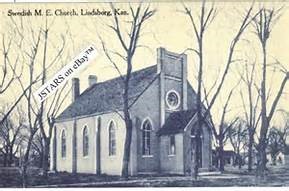Swedish Lutherans in Lindsborg
Lindsborg was founded in 1869 by Swedish immigrants from the Värmland region led by Lutheran Pastor Olof Olsson. The city’s population grew from 466 in 1880 to 1939 by 1910. Of those 1939 residents on the eve of World War 1, over 78% were born in Sweden or had at least parent born in Sweden. Given this predominant Swedish influence, an appreciation of Lindsborg’s Swedish heritage helps in understanding the community’s response to World War 1.
Historian H. Arnold Barton argued that Swedish immigrants of the late Nineteenth and early Twentieth Centuries were neither fully Swedish nor American; rather, they developed a unique Swedish American identity. Most of these Swedes retained an affinity for their homeland, but came to reject Sweden’s monarchial government, snobbishness, and rigid class system. They embraced “American ideals of freedom and equality in public and private life, of the dignity of honest labor, and of republican plainness and simplicity.”[1] Such views made most Swedish immigrants loyal Republicans during the Nineteenth Century; however, as monopolists came to dominate the GOP by the 1890s some Swedes abandoned the party for insurgent political movements such as Populists, Progressives, and Socialists.[2] In 1912, Bethany College President Ernst Pihlblad wrote to Progressive Republican Kansas gubernatorial candidate Arthur Capper that while Lindsborg was still overwhelmingly Republican, they split between conservative and progressive ideals.[3] Swedish immigrants embraced the American political system while ceasing to act as a bloc.

Likewise, as time progressed Swedes differed over how they viewed the culture of their homeland. Swedish gradually gave way to English as the language of choice, as evidenced by the creation of a rival English language Lutheran Church in 1908. Alfred Bergin, Pastor of the Swedish language Bethany Lutheran Church and native of Sweden, visited his homeland for the first time since 1883 in 1914 and wrote he was “at home, but yet a stranger,” even as he recalled what was idyllic of Sweden’s culture and countryside.[4] By the eve of World War I the Swedes of Lindsborg had a complicated relationship with their nation of origin.
When war erupted in Europe in 1914 Sweden declared complete neutrality and maintained that neutrality throughout the war. Most Swedes favored neutrality, although a small number, including those with connections to government and the royal family, called for intervention on behalf of the Germans.[5] Interest in the German cause remained throughout the war as Sweden took on greater trade relations with the Germans due to the British blockade of other global trade routes. More importantly, Swedes worried about their traditional enemy to the east, Russia, and what the war meant for Russian ambitions in Finland. Sweden has little interest in supporting an alliance that included Russia.
Anti-Russian sentiments manifested themselves in Lindsborg in the weeks following the declaration of war in Europe in 1914. Lindsborg’s Swedish-language newspaper, Lindsborgs-Posten, ran an editorial on August 12, 1914, placing more blame on the Slavic people, especially Russia, than the Germans who were typically blamed in English-language newspapers. In August 1914 such commentary probably drew little attention, but when the United States joined the war against Germany in 1917, issues of loyalty pertaining to Swedish Lutherans became more pronounced.
Continue on to: Swedish Heritage / Loyalty
[1] H. Arnold Barton, A Folk Divided: Homeland Swedes and Swedish Americans, 1840-1940 (Carbondale: Southern Illinois University Press, 1994), 63.
[2] Barton, 88-89.
[3] Ernst Pihlblad to Arthur Capper, October 1, 1912, Ernst Pihlblad Papers, Bethany College, Lindsborg, KS.
[4] Barton, 207.
[5] Franklin D. Scott, Sweden: The Nation’s History (Carbondale: Southern Illinois University Press, 1988), 469.
